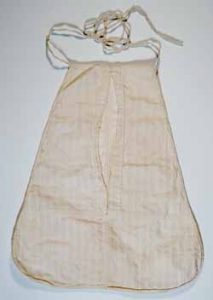Deep Pockets
Today’s post comes to you from Sally Meyer, current Tufts Museum Studies and History M. A. candidate.
In a blog post titled “The Weird Complicated Sexist History of Pockets,” Rachel Lubitz says that a lack of enough space to hold objects is something women have suffered through for hundreds of years. She finishes with the question “how much longer must we suffer?” While her position seems slightly exaggerated, she makes an important point. Clothing is essential to self-expression and societal understandings. Frequently, clothing can cause people to make judgments about what you value, your gender identity, and what your societal class is. However, the author’s blog fails to acknowledge how pockets and bags contain what we believe we cannot live without. Attachment to these objects, and the importance of pockets that hold them has not changed much in over two hundred years. A pocket that rests behind glass at the Massachusetts Historical Society, confirms this phenomenon.
This particular pocket, though it represents a broad and common need, is believed to have rested on the hips of Abigail Adams, abolitionist, women’s right advocate, and wife of John Adams. Pockets in general, and this one in particular, were not expensive or glamorous objects. Most however, that have survived the last two hundred years are often hand embroidered and decorated. This pocket is a much better representation of what ladies usually wore. It speaks volumes about Abigail Adams but it is also worth study because of what it says about the human and female condition. An analysis of how it was worn and used reveals the natural human attachment to objects.
Women in the 18th century had few rights to property no matter their social class. As such, pockets represented an opportunity to keep personal property close by. Much as people do today, Abigail Adams kept her keys in her tie-on pocket. For 18th century women, keys were indeed important to their status. Having keys close by would be a definitive source of emotional security. Pockets also held personal money. Pockets were valuable on their own, but mostly their value lay in what they contained. In addition to money and keys, women kept jewelry, mirrors, combs, personal letters, and even food in their tie-on pockets.

Much of what we carry with us today has only changed slightly since the 18th century. Money and keys dominate listings of what women carried in the pockets tied around their waist. These items ring true to our own pockets and handbags. Car keys, train passes, money, and cellular phones reflect a need to be mobile and communicate at will. House keys, membership cards, calendars, snacks, and bottled water help us make it through our day safely and securely. The concept of objects close at hand has permeated the lives of women and men for hundreds of years and continues to do so.
Pockets and what they contain are important evidence for what we value. Practicality has often surrendered to fashion when women’s clothing designs were not built for practical space. Historians reference pockets and how a lack of them in women’s clothing reflects a subtle sexism. Women are not supposed to need money and “things” in the same way men do. This 18th century pocket does show however, that women did need objects and personal items close at hand. Even the purposes of these items have not changed much at all even as society has shifted. Letters to cellular phones, oranges to granola bars, and pantry keys to car keys are not so different when placed side by side. Abigail Adams’s pocket was saved because it was associated with an important person. The object itself however reflects heavily the human, and female, condition.
Yes, the unsupported female condition. Dressed for appearance and not for convenience. Recently I bought a pair of pants with no pockets at all. I was horrified, especially since I used to slit skirt seams to sew pockets into them. Today most women carry pocketbooks, which I think is a kind of torture. The pocketbook is heavy, it pulls at your shoulder, and it always seems to attract detritus. Why can men get away without them? Can it be because they have pockets in their clothes? Abigail Adams’ pocket was a great idea.